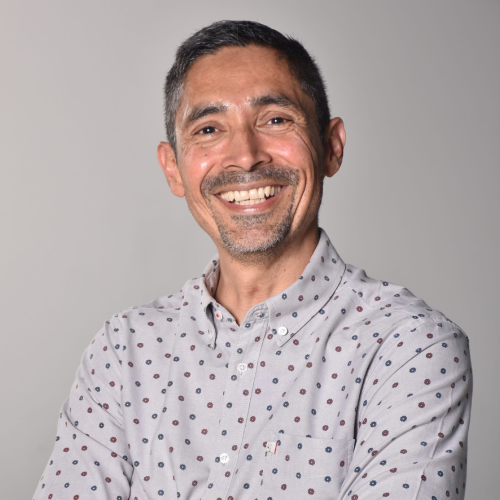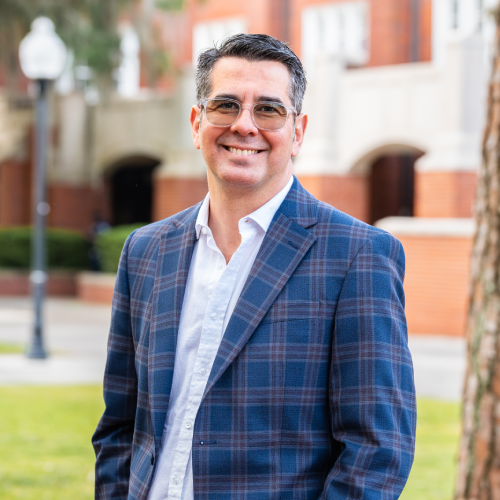


Luis Mejia, originally from Colombia, is Assistant Professor at the University of Florida in the department of Interior Design. He is an industrial designer with a masters’ in product development and doctoral studies in human sciences – and more specifically in interior design.
Luis teaches design studio and advanced communication courses including technology aspects of design. He undertakes research in pedagogical practices and in using technological ‘gimmicks’ into pedagogical practices and he loves virtual exchange!
Edgar Martinez Muñoz is the Director of Industrial Design at the Universidad Autonoma de Occidente in Cali, Colombia (UAO) where he teaches in the Faculty of Architecture. He is an industrial designer with a Masters’ in Interior Design, he’s been at UAO for the past 10 years. Edgar teaches many classes on interior design, experiential design and semiotics of design.
He is passionate about the international opportunities offered by doing virtual exchange.
Both got into virtual exchange after the University of Florida provided guidance and training in the pedagogy. Paloma Rodriguez was the inspiration behind the growth of VE/COIL at UF
A VE beyond spatial boundaries
Luis and Edgar have undertaken three iterations of their virtual exchange and both are very passionate about the benefits of virtual exchange and intercultural communication for their students.
Their virtual exchange (Where Interaction goes Beyond Spatial Boundaries) involves giving their students a floor plan of a designated to design an interior for their counterpart’s country.
Luis explains how important multicultural exchanges are for design disciplines and Edgar nods in complete agreement.
“We wanted studio practice to be at the core of our design discipline,’ he continues, our exchange is based around hypothetical projects where students have to come up with design solutions those hypothetical projects.
“Both of us wanted cultural exchange to be a central component of our project. As designers, it’s our job to first acquire information from our clients and come up with design development to give back to the clients to comment on so we can continue to work on a solution that everyone is happy with.
“And that goes for any design discipline be it architecture or interior design or whatever.
“We then get feedback from clients and we go on to develop products. It’s a continuous exchange of information and feedback till the design is delivered to their specifications.”
Using VE pedagogy to understand the context
Edgar and Luis’s first iteration of their virtual exchange took place in 2023, when they decided on the idea of using the interior design of a restaurant as a hypothetical project.
The students received a floorplan, and they had to take on the role of client and consumer/client and designer in order to be able to develop that space.
In this way, the students in the States were tasked with designing a restaurant for Colombia and the Colombian students were designing for the US.
Edgar explains how it was interesting to note that not all were interior designers. This was an interdisciplinary exchange so some were graphic designers, some were product designers, interactive media designers.
Edgar says, “It’s important to learn about the context when you’re designing. That virtual exchange project was really good as they had to understand where to put things on their floor plans. This required them to understand more about a city they had never been to. I love that.
“Another great thing to emerge from this was that the medium the students used to present their work at the end was different according to their discipline. So, the graphic designers used a lot of drawings and illustrations whilst other disciplines used respective technology to showcase their design. That is why context and culture is essential.
A good starting point for the virtual exchange
Edgar explains that the starting point for all of this was for all students to meet each other, and interview each other. This was to enable them to get the relevant knowledge about their respective towns.
“That first contact was really important, explains Edgar. “They think this is easy, but it really isn’t. They had to work around their different schedules and also I want to mention that the language barrier was really hard.”
By requiring the students to meet and interview each other, the educators created a need that required the students to reach out to their counterparts. They needed each other to get that information so they could continue with their exchange projects. This is an essential aspect of a virtual exchange.
Luis says, “We, as educators threw them into the situation and gave them very little information. They had to find it. A simple google search was not enough to give them what they needed. They had to have that ‘exchange’ to find the relevant information.
“When you speak face-to-face and ask each other ‘what is a day like in your life?’ well, that’s not on google. At the start, we created teams and exchanged their emails and invited them to reach out to each other to make contact.
“To prove they had met, we required screen shots of their meetings and a ‘diary,’ if you like, to demonstrate they had made contact with their counterpart.”
Relationship building and trust
Luis explains that they began sharing more than just when they met up. They also began sharing their designs with each other and asking for feedback from their counterparts. That is how the virtual exchange evolved just as we had hoped – that they would be client/designer.
Both Edgar and Luis refused to answer certain questions in class about cultural aspects such as food. They replied that the students needed to ask those sorts of questions to their counterparts.
In this way, the students took ownership of the project and were very much left to their own devices regarding how and when to contact their peers.
Challenges to overcome
Edgar says that language was an issue that the students had to work around. Many of his students didn’t feel they had adequate English for the tasks, despite all the presentations and briefs being in English.
“My students could not always speak in English, so they had some difficulties expressing themselves. Sometimes they were able to use Spanish and in this case AI was helpful to them.”
Luis says he saw interactions where the translator would take the lead, usually the one who knew a bit of Spanish.
“My takeaway is they figure it out, they figure out how to communicate.”
Extra learning during the virtual exchange
Ultimately, as well as the design aspects of the virtual exchange, some learned some Spanish along the way and others improved their English language skills. In fact, all super useful competencies to work globally, which is likely what most students will end up doing.
“Our second iteration in 2024 was really interesting too,’ says Luis. “There was a really important bio-diversity conference in Cali and so we used the occasion and asked our students to design a museum to showcase Colombia’s bio-diversity. It was a UN biennial conference and that year, Colombia was selected due to its biodiversity.
This year the students will be working on a hospitality lobby hotel, with Luis’ students designing a hotel for Cali Colombia and Edgar’s students will do the opposite.
“One thing to point out, says Luis, ‘is the experiential interactive aspect of this virtual exchange. We want tech savvy students but we want the emphasis to be on the experiential.”
Keeping up the motivation
There is no doubt that Edgar and Luis have an enduring and successful partnership. But it’s also true that Luis has more institutional buy-in and support at the University of Florida. It’s not quite the same for Edgar.
“My motivation is my close relationship with Luis. I want my students to learn something about design and I love to talk design and discuss with them. We do have a program here which enhances international exchanges. In fact, Luis was here. But, yes, it is difficult here for me.
“But we love what we do and we will continue. I want my students to understand other cultures and other perspectives. It’s our ‘love child’ and we are committed to it.”
Luis says, “Everything starts with a good relationship and Edgar and I have this. This virtual exchange is our baby and it’s been growing. We had wanted to include Mexico too, but scheduling conflicts prevented this. In the future, we will work this out and get them on board.”
But, first and foremost, it is a personal relationship and Edgar and Luis doing something for their students, and building trust with each other.
“I know when I reach out to Edgar next year, he’ll be there. Along with all the planning and sacrifices it entails. We know it’s worth it for our students….
“If we get Mexico or others on board and we can grow it, that would be great.
It’s of course super helpful that the US and Colombia are in the same time zone more or less.
“We love what we do,’ says Edgar, ‘ it’s a great opportunity for our students because through such a project, they are expanding their vision of the world. I am proud of that. It is really invigorating.
